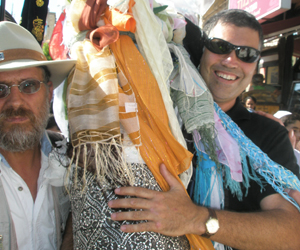Alsheich Synagogue
Untouched By The Earthquakes
This synagogue is named for Rabbi Moshe Ben Haim Alsheich and an inscription above the lintel at the entrance to this synagogue reads: "This is the synagogue of Rabbeinu Moshe Alsheich, may his merit protect us, Amen." The synagogue was built more than 500 years ago during what was known as Safed's Golden Era, and documents remaining from that time tell us that this synagogue was the place to be during this time period. Rabbi Alsheich gave weekly torah readings in this building, and even the famed Rabbi Issac Luria and Rabbi Joseph Caro came to hear him speak. Many of his teachings were written down and you can find them, including English translations, in just about any Torah library.
The unique arches of the building are attributed to the Samarkand style of building of the Jews of Bukhara. Legend has it that the synagogue was not damaged in the earthquakes of 1759 and 1837 specifically due to the strength of these arches.
The Other Name
The synagogue is also called "the synagogue of the Ba'alei Teshuva" (penitent Jews). Visitors are shown a silver Torah scroll cover, bearing an inscription from the year 1434 "for the synagogue of the Ba'alei Teshuva." It is assumed that this phrase refers to the Conversos, Spanish Jews who converted to Christianity during the Inquisition and returned to Judaism after fleeing from Spain. Another name by which the synagogue is known is Kenis el Istambulia - the synagogue of the Jews from Istanbul, which could also allude to the Ba'alei Teshuva of the fifteenth and sixteenth centuries.
The Building
The synagogue is built in the style of the Sephardic synagogues of the sixteenth century. It does not have a women's section. The prayer hall has pointed arches that support the domed roof. An inscription on the facade of the building attests to a renovation carried out before the earthquake of 1837. This renovation apparently saved the building from destruction. Three people are mentioned in the inscription: the builder, Ya'acov Peleggi, philanthropist Yehezkel Reuven Menashe, and the intermediary, Rabbi Ya'acov Anavti, the rabbi of Damascus at the time. After the renovation, the synagogue was renamed Knesset Yehezkel, in honor of the philanthropist.
Visiting Hours
Visiting this synagogue has become difficult in recent years. After theives stole valuable artifacts from the synagogue, its caretakers decided to close the doors to tourists. However, it is possible to glimpse inside the building during Shabbat morning prayers or in the evenings prior to evening prayers.

